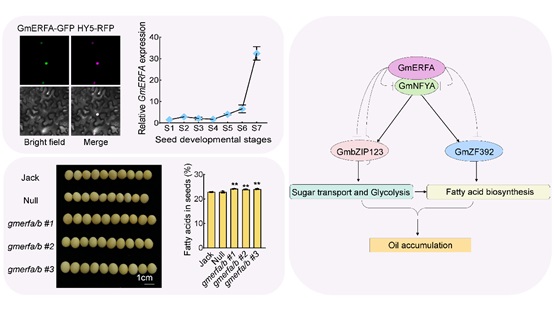Soybean (Glycine max) is one of the most important oilseed crops worldwide. Its economic value and industrial applications are directly dictated by its seed oil content. Soybean oil accounts for over half of the global oilseed production, and serves as a vital source of both edible oil and industrial raw materials, making it significant economic value. However, oil accumulation biosynthesis is finely regulated by numerous factors, and the underlying regulatory mechanisms await further elucidation.
A research team led by Prof. ZHANG Jinsong from the Institute of Genetics and Developmental Biology of the Chinese Academy of Sciences has uncovered a brake gene for oil control in soybeans. This discovery has implications for improving oilseed crop productivity and addressing global demands for sustainable vegetable oil sources.
Their study, published in
Plant Biotechnology Journal on September 4, reveals a novel molecular network, GmERFA-GmNFYA-GmbZIP123/GmZF392, which integrates multi-dimensional regulation (transcriptional and protein-protein interaction networks) to explain natural variation in soybean oil content, and deepens the understanding of the connections among different oil regulators.
Through RNA sequencing analysis and screening for the interacting proteins of a positive oil regulator GmNFYA, the researchers identified an AP2/ERF-type transcription factor GmERFA, which is located in nucleus and acts as a negative regulator of oil accumulation. GmERFA is steadily expressed during the soybean seed development, and increases sharply at the later maturation stage. The researchers further utilized gene-editing technology to generate double mutant soybeans targeting GmERFA and its homologs. All the gmerfa/b mutants produced larger seeds with more weight and more oil.
The importance of GmERFA-GmNFYA-GmbZIP123/GmZF392 network lies in its regulation of the balance and selection of energy substances such as sugars, oils, and proteins during soybean seed development. Sugars are critical precursors for the biosynthesis of oils and proteins. In this network, GmNFYA activates the downstream genes GmbZIP123 and GmZF392, These genes regulate sugar transport and metabolism, and promote the expression of genes related to oil biosynthesis. This enhances seed oil accumulation.
Conversely, GmERFA negatively regulates oil biosynthesis. It directly suppresses the expression of GmbZIP123 and GmZF392 or interfere with the transcriptional activation ability of GmNFYA by interacting with it. GmERFA effectively reduces sugar transport to the seeds and inhibits sugar metabolism, thereby suppressing oil biosynthesis. As GmERFA expression rises sharply during the S6-S7 stages of seed development, functioning as a "braking mechanism" that suppresses oil biosynthesis in later developmental stages. This process also signals the seed's transition into dehydration and maturation.
Due to the negative correlation between oil and protein content, increasing GmERFA expression to inhibit oil biosynthesis can adjust the relative proportions of oil and protein. Therefore, GmERFA is also a key target in soybean breeding process aimed at developing varieties with different oil and protein contents. It is projected that the global demand for vegetable oil will double by 2050. The molecular network GmERFA-GmNFYA-GmbZIP123/GmZF392 identified in this study provides a critical genetic theoretical foundation and innovative breeding strategies for developing high-oil soybean varieties.
The research team led by Prof. ZHANG Jinsong has identified several transcription factors including positive regulators GmDOF4/11, GmbZIP123, GmMYB73, GmDREBL, GmNFYA, GmZF351 and GmZF392, as well as the present negative regulator GmERFA, it is not clear why soybean needs multi-factors for oil control. It is possible that these factors may work at different stages and/or processes singly or combinatorially for a proper source/sink allocation and a suitable oil/protein level, producing a seed for better propagation and survival to the environments.
This work was supported by the STI 2030-Major Projects, the National R & D project and the National Natural Science Foundation of China.
The Regulatory Role of GmERFA in Soybean Seed Oil Accumulation (Imagy by IGDB)





